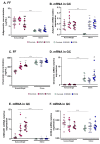Ovarian Expression of Adipokines in Polycystic Ovary Syndrome: A Role for Chemerin, Omentin, and Apelin in Follicular Growth Arrest and Ovulatory Dysfunction?
- PMID: 31382403
- PMCID: PMC6695651
- DOI: 10.3390/ijms20153778
Ovarian Expression of Adipokines in Polycystic Ovary Syndrome: A Role for Chemerin, Omentin, and Apelin in Follicular Growth Arrest and Ovulatory Dysfunction?
Abstract
Adipokines are a potential link between reproduction and energy metabolism and could partly explain some infertilities related to some pathophysiology, such as polycystic ovary syndrome (PCOS). However, adipokines were predominantly assessed in blood samples, while very little is known concerning their variations in follicular fluid (FF) and ovarian granulosa cells (GCs) of PCOS women. Thus, the objectives of our study were to investigate adiponectin, chemerin, resistin, visfatin, omentin, and apelin ovarian expression in PCOS women in comparison with controls and women with only a polycystic ovary morphology. In total, 78 women undergoing an in vitro fertilization procedure were divided into three groups: 23 PCOS women, 28 women presenting only ≥12 follicles per ovary (ECHO group), and 27 control women. Each group almost equally included normal weight and obese women. Follicular fluid (FF) concentration and granulosa cells (GCs) mRNA expression of adipokines and their receptors were assessed by ELISA and RT-qPCR, respectively. Omentin levels in FF and GC were higher in PCOS than in ECHO and control women, while apelin expression was increased in both PCOS and ECHO groups. FF chemerin concentration was predominant in normal-weight PCOS women compared to BMI (Body Mass Index)-matched ECHO and control women, while GC mRNA levels were higher in the obese PCOS group than in the ECHO one. Compared to PCOS, ECHO women had increased FF adiponectin concentrations and lower plasma AMH levels. The FF concentration of all adipokines was higher in obese subjects except for adiponectin, predominant in normal-weight women. In conclusion, women with PCOS expressed higher GC chemerin and omentin, whereas the ECHO group presented higher levels of FF adiponectin and apelin and lower plasma AMH and LH concentrations. Chemerin, omentin, and apelin expression was differently regulated in women with PCOS, suggesting their possible role in follicular growth arrest and ovulatory dysfunction characterizing PCOS pathogenesis.
Keywords: PCOS; adipokines; follicular fluid; human granulosa cells; polycystic ovary morphology.
Conflict of interest statement
The authors declare no conflict of interest. The funders had no role in the design of the study; in the collection, analyses, or interpretation of data; in the writing of the manuscript, or in the decision to publish the results.
Figures




Similar articles
-
High androgen concentrations in follicular fluid of polycystic ovary syndrome women.Reprod Biol Endocrinol. 2022 Jun 14;20(1):88. doi: 10.1186/s12958-022-00959-6. Reprod Biol Endocrinol. 2022. PMID: 35701786 Free PMC article.
-
Significance of pro-angiogenic estrogen metabolites in normal follicular development and follicular growth arrest in polycystic ovary syndrome.Hum Reprod. 2020 Jul 1;35(7):1655-1665. doi: 10.1093/humrep/deaa098. Hum Reprod. 2020. PMID: 32558920 Free PMC article.
-
Evidence for masculinization of adipokine gene expression in visceral and subcutaneous adipose tissue of obese women with polycystic ovary syndrome (PCOS).J Clin Endocrinol Metab. 2013 Feb;98(2):E388-96. doi: 10.1210/jc.2012-3414. Epub 2013 Jan 21. J Clin Endocrinol Metab. 2013. PMID: 23337724
-
Serum and follicular fluid chemerin and chemerin mRNA expression in women with polycystic ovary syndrome: Systematic review and meta-analysis.Endocrinol Diabetes Metab. 2022 Jan;5(1):e00307. doi: 10.1002/edm2.307. Epub 2021 Oct 26. Endocrinol Diabetes Metab. 2022. PMID: 34699139 Free PMC article.
-
Adipokines in reproductive function: a link between obesity and polycystic ovary syndrome.J Mol Endocrinol. 2013 Mar 18;50(2):R21-37. doi: 10.1530/JME-12-0247. Print 2013 Apr. J Mol Endocrinol. 2013. PMID: 23335807 Review.
Cited by
-
The adipokines progranulin and omentin - novel regulators of basic ovarian cell functions.Reprod Biol Endocrinol. 2024 Apr 4;22(1):38. doi: 10.1186/s12958-024-01215-9. Reprod Biol Endocrinol. 2024. PMID: 38575956 Free PMC article.
-
DeepGP: An Integrated Deep Learning Method for Endocrine Disease Gene Prediction Using Omics Data.Front Cell Dev Biol. 2021 Jul 6;9:700061. doi: 10.3389/fcell.2021.700061. eCollection 2021. Front Cell Dev Biol. 2021. PMID: 34295899 Free PMC article.
-
Progress of Adipokines in the Female Reproductive System: A Focus on Polycystic Ovary Syndrome.Front Endocrinol (Lausanne). 2022 May 26;13:881684. doi: 10.3389/fendo.2022.881684. eCollection 2022. Front Endocrinol (Lausanne). 2022. PMID: 35692386 Free PMC article. Review.
-
The Molecular Basis of Polycystic Ovary Syndrome and Its Cardiometabolic Correlates: Exploring the Intersection and Its Clinical Implications-A Narrative Review.Biomedicines. 2025 Mar 13;13(3):709. doi: 10.3390/biomedicines13030709. Biomedicines. 2025. PMID: 40149685 Free PMC article. Review.
-
Adipokine levels and carbohydrate metabolism in patients diagnosed de novo with polycystic ovary syndrome.Qatar Med J. 2021 Aug 31;2021(2):34. doi: 10.5339/qmj.2021.34. eCollection 2021. Qatar Med J. 2021. PMID: 34604014 Free PMC article.
References
-
- Teede H.J., Misso M.L., Costello M.F., Dokras A., Laven J., Moran L., Piltonen T., Norman R.J., International P.N. Recommendations from the international evidence-based guideline for the assessment and management of polycystic ovary syndrome. Fertil. Steril. 2018;110:364–379. doi: 10.1016/j.fertnstert.2018.05.004. - DOI - PMC - PubMed
-
- Benrick A., Chanclon B., Micallef P., Wu Y., Hadi L., Shelton J.M., Stener-Victorin E., Wernstedt Asterholm I. Adiponectin protects against development of metabolic disturbances in a PCOS mouse model. Proc. Natl. Acad. Sci. USA. 2017;114:E7187–E7196. doi: 10.1073/pnas.1708854114. - DOI - PMC - PubMed
MeSH terms
Substances
Grants and funding
LinkOut - more resources
Full Text Sources
Medical
Miscellaneous

